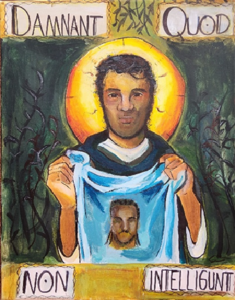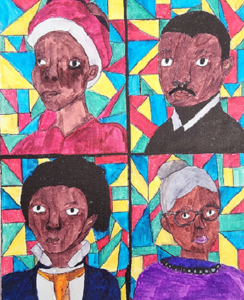1st PLACE WINNER
Congratulations to the 1st place winner of the SMS Black History Month Contest, Maren Williamson, for her digital artwork featuring Black Catholic saints and the first African Americans now on the journey to sainthood. Below are a few frames of Maren’s work. Don’t miss the digital showing at all Masses on February 25th.
2nd PLACE WINNER
 From the Artist, Isabella Matusalem:
From the Artist, Isabella Matusalem:
My painting, Saint Martin de Porres in his youth is seen holding the Veil of Veronica, the veil Veronica wiped on Jesus’face before this death. As shown on the Veil of Veronica, Jesus’ face is shown to be an African American male. Near all four corners of the painting, the words “Damnant Quod Non Intelligunt”, a phrase first used by Quintilian, is shown; the phrase translates to “They condemn what they do not understand”. Damnant Quod Non Intelligunt symbolizes to all of the Christian black African Americans who were condemned unfairly. The phrase can also connect to Jesus, who was wrongfully condemned.
(Acrylic, charcoal and alcohol markers on canvas).
3rd PLACE WINNER
Black History Continues to Flourish
by Lemi Bartholemieux-Doxy
In the bustling streets of history
where shadows of oppression cast their long gaze,
Black culture emerged,
A resilient phoenix rising from the ashes of struggle.
Langston Hughes, a poetic maestro, captured the heartbeat of this culture, a rhythm that
refused
to be silenced.
From the days of cotton fields,
where the echoes of sorrow were met with soulful hymns, to the pulsating energy of urban life,
Black culture has not merely survived;
it has flourished.
The roots of heritage run deep, intertwining tales of triumph and tribulation, creating a
vibrant
tapestry that defies erasure.
Zora Neal Hurston’s tales and Hughes’ poetic verses became anthems of resistance,
celebrating the beauty and strength of blackness.
As time marched on, the narrative evolved.
Gospel choirs filled the air with melodies of faith,
while the streets resonated with the raw beats of hip-hop,
Each verse a testament to resilience and the unyielding spirit of black culture.
In the quiet moments, under the ebony sky,
The stories persist-the struggles, the victories, the unbreakable bond that weaves
through time.
Langston’s legacy lives on, echoing in the whisper of the poetry
Black culture is not a relic of the past;
it is a dynamic force,
an ever-evolving symphony that continues to shape the world with its enduring presence.
Honorable Mentions:
 Artist: Yuna Augatis
Artist: Yuna Augatis
Harriet Tubman, Martin Luther King, Jr. Frederick Douglass and Rosa Parks in Stained Glass on canvas.
Isabel McGuire
Medgar Evers
Born July 2nd, 1925, a true leader changed our world. Medgar Evers grew up in a time of racial inequality and oppression. Like many others, he faced such racial unfairness and cruelty. Though life was a struggle for Evers, we always made an effort to protest the Jim Crow laws that divided the South. Evers strongly believed in education and made a great effort to protest against any laws supporting segregation in schools. From a horrible experience, Evers became a Civil Rights leader, having been shown how racist people were. Evers was about to vote at a local election when he was turned away, and threatened to be killed if he did not. Evers had just returned from fighting in World War II and realized fighting for his country had done nothing. Racism was still widespread, and that was not what Evers had fought for. He fought for equal rights, and that was what he was determined to achieve. After attending college at Alcorn State in Mississippi, Evers obtained a job in Mound Bayou, a town highly populated with Black people. While at this job, Evers became the president of the Regional Council for Negro Leadership (RCNL). He began a boycott of gas stations that would not allow Black people to use their restrooms, using the slogan, “Don’t buy gas where you can’t use the restroom.” This, along with many other protests of his, attracted thousands of people who protested for their rights.
1954, Evers was rejected from the University of Mississippi Law School because of the color of his skin. Now Evers had another goal: to desegregate the school and was successful in doing so when James Meridith was enrolled in 1962. These achievements are only a few of Evers’. He changed the world so much for the better. He established new local chapters, organized voter registration drives, and led protests against segregation in schools. Although Evers was thriving in all his successes, there were still white people out to get him. As Evers eventually became a lawyer, he gained more notoriety, especially from white supremacists. There were two severe cases Evers endured, one accusing an innocent Black male of murder, and the other being that a 14-year-old Black male was lynched. This showed Evers he needed to continue his protest, but white supremacists continued to be unhappy with all his accomplishments. It was not until Evers walked around carrying T-shirts stating, “Jim Crow Must Go,” that he was shot in the head on June 12, 1963, by a Klu Klux Klan member. His murder happened not long after President John F. Kennedy’s speech on television in support of civil rights. Evers was buried with military honors in front of 3,000 people at Arlington National Cemetery and is honored today by songs and movies representing his life. His family continued to live on his legacy, becoming civil rights leaders, and we shall do the same for him, a true hero who helped change our world.
Connor Lyons
This work is an essay about the history and impact of African American musical genres
History of African American Music
African Americans have had a major impact on music and its genres. African American music has existed for over three centuries. African American musicians throughout history such as Aretha Franklin, Scott Joplin, Louis Armstrong, and Ray Charles made very innovative and influential music. Many musical genres have African American genres have roots such as jazz, gospel, blues, and many more.
Jazz is a musical genre that dates back to the early 20th century where syncopation and improvisation play an important role. Jazz was made from African American genres such as blues and ragtime mixed with other kinds of music. African American musicians such as Duke Ellington and Louis Armstrong played a key role in the growth of jazz. Jazz led to the development of other musical styles and is now a very popular genre today.
Gospel music is a style of Christian music that can be traced to the early 17th century. African American gospel music started in the days of slavery. Christian slaves would sing hymns which evolved into gospel music. African American gospel music had a rise in popularity in the 1930s, with a key source of this growth being Thomas A. Dorsey, who is referred to now as the father of gospel music. The genre is still very popular and has made a big impact on popular music today.
The blues is primarily a lyrical form of music that was developed in the Southern United States after the Civil War. It was influenced by ragtime, gospel music, and other types of music. The blues genre derived from free African Americans expressing their disappointment in a post-slavery society in 1912. African American W.C. Handy published “Memphis Blues” which led to the popularization of the blues. The blues influenced many genres like jazz and is the origin of many popular music today.
Overall African American music has been very influential and popular in the past, and it still is today. Many musical genres were created or influenced by African Americans, including hip-hop, rap, soul, rock, electronic, and many more. It is obvious that African American music will continue to develop and thrive in the future.
